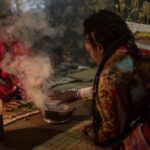Kote barani Afrika, asili si mandhari tu bali ni maandishi matakatifu. Miti, mito, mawe, milima, na misitu si mandhari tulivu; ni washiriki hai katika maisha ya kiroho ya jumuiya. Vipengele hivi vinashikilia kumbukumbu, huwasilisha nguvu za mababu, na mara nyingi huonekana kama wapatanishi kati ya ulimwengu wa kimwili na wa kiroho. Katika jamii nyingi za Kiafrika, kosmolojia ya kiroho ina msingi wa ardhini kumaanisha kwamba ikolojia na kosmolojia hazitenganishwi.
Asili kama Embodiment ya Kimungu
Katika dini za Asilia za Kiafrika, maeneo matakatifu katika asili yanachukuliwa kuwa makao ya miungu, roho, na mababu. Imani hii si ya kiishara wala si mfano ni halisi. Kuingiliana na asili kunatawaliwa na sheria za kiroho, na mahali fulani hufikiwa na matambiko, matoleo, au sala.
- Miongoni mwa Wayoruba wa Nigeria, Mto Osun unaaminika kuwa mfano halisi wa mungu wa kike Osun, mungu wa upendo, uzazi, na maji safi. The Osun-Osogbo Sacred Grove, ambalo sasa ni Maeneo ya Urithi wa Dunia wa UNESCO, hujenga madhabahu, sanamu, na madhabahu ambapo Osun huabudiwa kila mwaka wakati wa tamasha la Osun-Osogbo. Mto sio maji tu, ni asili ya kimungu.
- Nchini Ethiopia, Waisraeli wa Beta (Wayahudi wa Ethiopia) waliheshimu vilele fulani vya milima kuwa mahali pa ufunuo wa kimungu, sambamba na Mlima Sinai wa Biblia.
- Kusini mwa Zimbabwe,, Magofu makubwa ya Zimbabwe zimejengwa kuzunguka kilima kitakatifu ambacho hapo awali kilitumika kama kitovu cha kiroho ambapo waliaminika kuwa roho za mababu hukaa.
- Nchini Burkina Faso,, Walobi na watu wa Bobo kudumisha mashamba matakatifu na madhabahu za mawe ambapo dhabihu hutolewa kwa “thila,” roho za asili zinazolinda zinazohakikisha upatano wa jumuiya.
Miti Mitakatifu: Walinzi, Mahekalu, na Wapatanishi
Miti ni kati ya alama zenye nguvu zaidi katika kosmolojia ya kiroho ya Kiafrika. Wengi hutendewa kama viumbe vya mababu, madhabahu zilizo hai, au maneno matakatifu. Kuzikata bila ruhusa ya kitamaduni kunaweza kusababisha laana au bahati mbaya ya jamii.
- Mbuyu (Adansonia digitata): Inapatikana kote Senegal, Mali, na Madagaska, mibuyu mara nyingi ni viashirio vya kuzikia na maeneo ya matambiko. Baadhi wanaaminika kuwa na roho za mababu au kutumika kama mahali pa kukutania ambapo wazee wa jamii hupatanisha mizozo chini ya matawi yao.
- Mti wa Iroko (Milicia excelsa): Katika Kosmolojia ya Kiyoruba, Iroko inaogopwa na kuheshimiwa. Inaaminika kuwa roho hukaa ndani yake, na kuni zake huvunwa tu baada ya mila ya kina. Nchini Ghana, mwenzi wa mti huo - odum - hutumika kufanya "ngoma zinazozungumza" kuwa msingi wa mawasiliano na mizimu.
- Miti ya Mugumo (Ficus sycomorus): Miongoni mwa Wakikuyu wa Kenya, mugumo unachukuliwa kuwa mtakatifu. Matamko muhimu ya kisiasa na sherehe za kutengeneza mvua bado zinafanywa chini ya miti hii ya kale. Kukata mugumo bila ruhusa kutoka kwa wazee kunachukuliwa kuwa kosa la kiroho.
- Okoumé na Miti Mitakatifu ya Gabon: Katika mila za kiroho za Bwiti, mmea wa iboga na miti mahususi ya msitu wa mvua huonekana kama dawa takatifu na mifereji ya maono ya mababu. Miti hufikiwa kwa nyimbo na matoleo kabla ya gome au mizizi kuvunwa.
Misitu ya Roho: Mahali Patakatifu Zaidi ya Kuonekana
Misitu yote imehifadhiwa kama mahekalu hai. Nafasi hizi mara nyingi hufungwa kwa maendeleo, kilimo, au hata kuingia kwa kawaida bila ruhusa ya kiroho.
- Msitu wa Damba (Benin): Katikati ya mazoea ya Vodun, Damba ni "msitu uliokatazwa" ambapo makuhani walioanzishwa pekee ndio wanaweza kuingia. Miti na miungu mwenyeji wa ardhi kama Dani (roho ya nyoka) na Legba (mlinzi wa vizingiti)
- Msitu wa Chongoni Rock (Malawi): Zaidi ya maelfu ya michoro yake ya sanaa ya mawe na watu wa Chewa, msitu huu unatumika gule (ngoma za barakoa), ibada za jando, na ibada ya mababu
- Kayas (Misitu ya Pwani ya Kenya): Jamii za Mijikenda zinalinda misitu ya kaya, zilizochukuliwa kuwa nyumba takatifu za mababu. Visitu hivi sasa vimetangazwa kuwa tovuti za kitamaduni za UNESCO na zinalindwa chini ya sheria za jadi na mifumo ya kisasa ya uhifadhi.
- Vichaka Vitakatifu vya Ghana: Miongoni mwa Waakan, misitu mitakatifu inayoitwa tovuti za “abosom” inalindwa kama nyumba za miungu ya huko. Kukiuka utakatifu wa msitu hufikiriwa kuleta ukame au magonjwa.
Mandhari kama Kumbukumbu ya Cosmic
Milima, mapango, maporomoko ya maji, na miamba hutumika kama alama za kiroho, mahali ambapo mbingu na dunia hukutana.
- Mlima Kilimanjaro (Tanzania): Wachagga wanaiona kama makazi ya Ruwa (pia anajulikana kama Ngai), mungu muumbaji. Sadaka zilitolewa mara moja kwenye miteremko yake ya chini kabla ya uwindaji mkubwa au mabadiliko ya maisha.
- Mapango ya Drakensberg (Afrika Kusini): Yaliyochorwa na Wasan/Bushmen, mapango haya yanaonyesha safari za maono na dansi za njozi zinazoaminika kuwaruhusu shaman kufikia ulimwengu wa roho. Picha hizo, za maelfu ya miaka, zinajumuisha elands, mizimu, na wanyama mchanganyiko wa binadamu.
- Olumo Rock (Nigeria): Kwa watu wa Egba, sehemu hii ya granite haikuwa tu ngome wakati wa vita lakini pia tovuti takatifu ya ibada ya mababu. Leo inawavutia wageni kama ishara ya ujasiri wa Kiyoruba na hali ya kiroho.
Tambiko Zinazotokana na Asili
Taratibu za asili bado ni muhimu katika jamii nyingi za Kiafrika leo:
- Libations humwagwa chini kabla ya maombi, milo, au mikusanyiko ya familia ili kuheshimu mababu na roho za ardhini.
- Sherehe za kumtaja mtoto wakati mwingine huwekwa chini ya miti mitakatifu inayoaminika kutoa sifa kama vile hekima, nguvu, au uzazi.
- Uponyaji wa mitishamba haihusishi tu sifa za dawa lakini ruhusa za kiroho. Mganga anaweza kuomba, kuimba, au kuacha sadaka kabla ya kuvuna gome au majani.
- Sikukuu za kilimo kama Tamasha la Yam nchini Nigeria na Ghana huheshimu fadhila na walinzi wa kiroho wa mavuno.
Shinikizo za Kisasa na Kurudi kwa Ikolojia ya Wahenga
Licha ya umuhimu wao wa kiroho na kiikolojia, tovuti takatifu za asili zinakabiliwa na vitisho:
Changamoto:
- Ukataji miti na ukataji miti, hasa katika Afrika Magharibi na Kati, wameharibu misitu iliyohifadhiwa kwa vizazi vingi.
- Mabwawa na miundombinu miradi kama vile Bwawa la Gibe III nchini Ethiopia inatishia mito mitakatifu kama Omo.
- Ongezeko la miji na ubinafsishaji wa ardhi wamemeza ardhi ya mababu bila kujali umuhimu wake wa kiroho.
- Kupoteza maarifa ya vizazi, vizazi vijana wanapohamia mijini au kukumbatia dini za kimataifa.
Uamsho na Ulinzi:
- Katika Kenya, Makavazi ya Kitaifa ya Kenya hufanya kazi na wazee kuweka ramani na kulinda kisheria misitu ya kaya na miti ya mugumo.
- Katika Ghana na Cameroon, miradi ya ramani ya mazingira inarejesha ulinzi wa misitu unaoongozwa na jamii.
- Harakati za eco-kiroho za vijana wanarejesha ibada za mababu katika sherehe na harakati za hali ya hewa
- Juhudi za dini mbalimbali katika Nigeria, Malawi na Uganda sasa ni pamoja na walinzi wa jadi katika uundaji wa sera za mazingira.
Tafakari ya Mwisho
Katika Kosmolojia ya Kiafrika, asili sio mandhari, ni maandiko. Miti, mito, na misitu si mazingira tu, bali maandishi matakatifu yaliyoandikwa kwa hekima ya mababu. Kuzihifadhi sio tu uhifadhi wa ikolojia ni mwendelezo wa kiroho. Kadiri mabadiliko ya hali ya hewa yanavyoongezeka na tovuti takatifu zinakabiliwa na kufutwa, kurejea kwa hekima ya ikolojia ya Asilia ya Kiafrika hakutoi ulinzi tu kwa dunia bali urejesho wa usawa kati ya binadamu, roho na udongo.
Machapisho yanayohusiana
-
Utalii wa Mazingira barani Afrika: Safaris, Uhifadhi, na Athari za Jamii
Gundua jinsi utalii wa mazingira barani Afrika unavyobadilisha usafiri kuwa nguvu ya manufaa—kulinda wanyamapori, kuwezesha jamii,…
-
Wainga mganga: Uchawi, hekima, na upinzani katika Mkoloni Kenya
Chunguza kisa cha Wainga, mganga wa Nyeri anayeshutumiwa kwa “kujihusisha na Shetani” wakati wa…
-
Wanyama Wenye Hekima na Viumbe Wenye Hila: Hadithi za Wanyama na Hadithi katika Hadithi za Kiafrika
Kwa mwanga wa mwanga wa moto, hadithi ziliambiwa sio kuburudisha tu, bali kupitisha…


